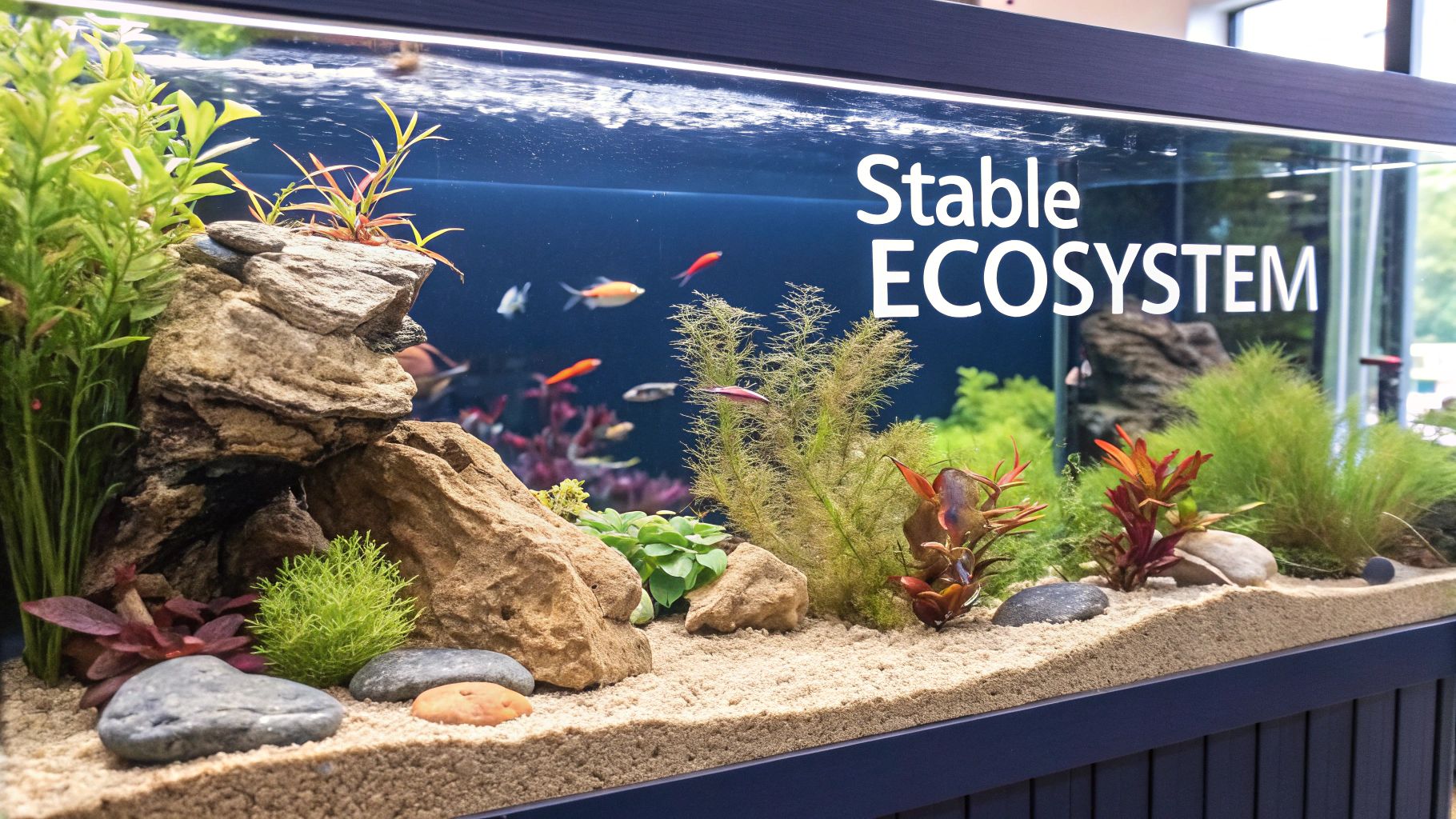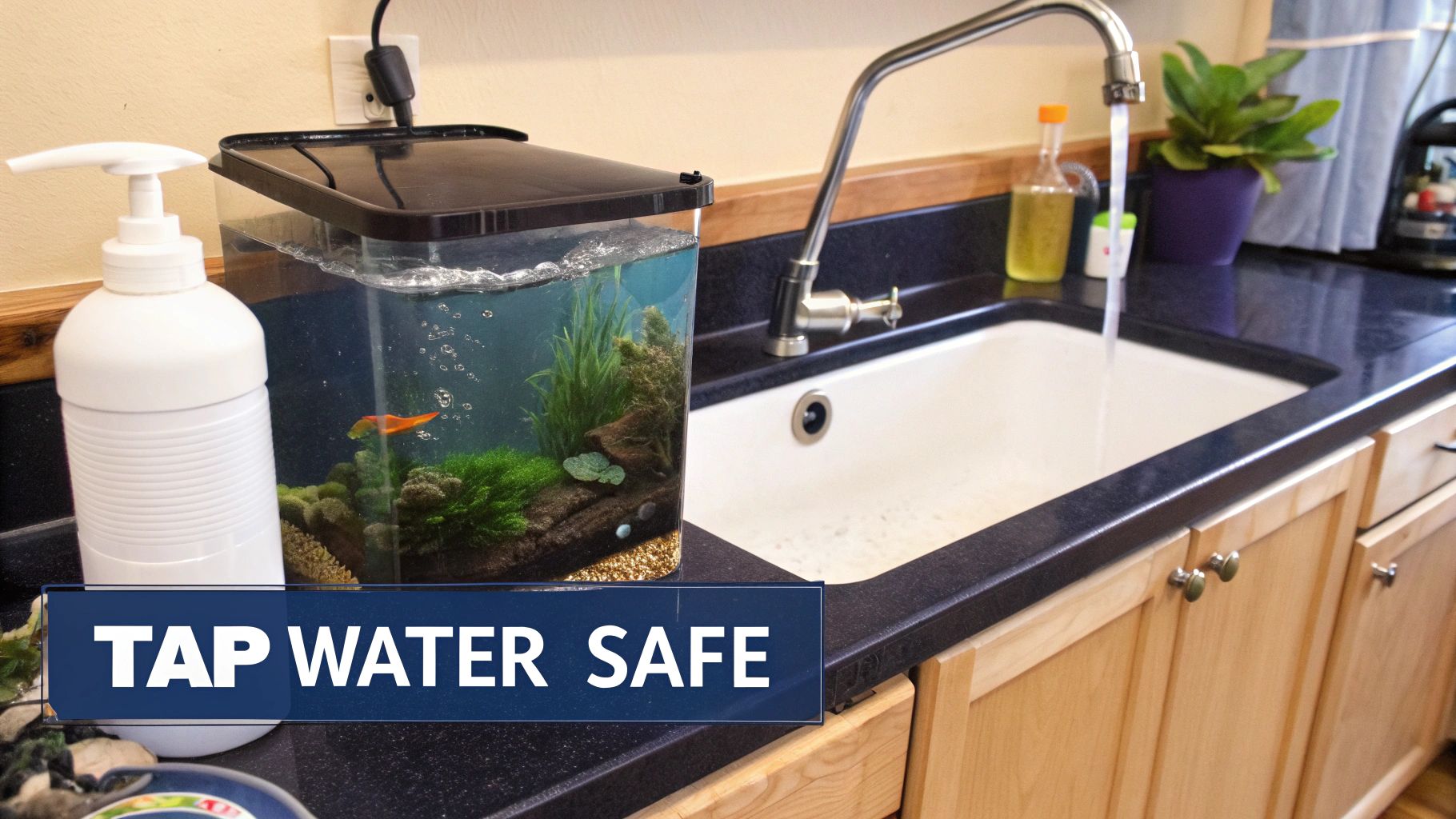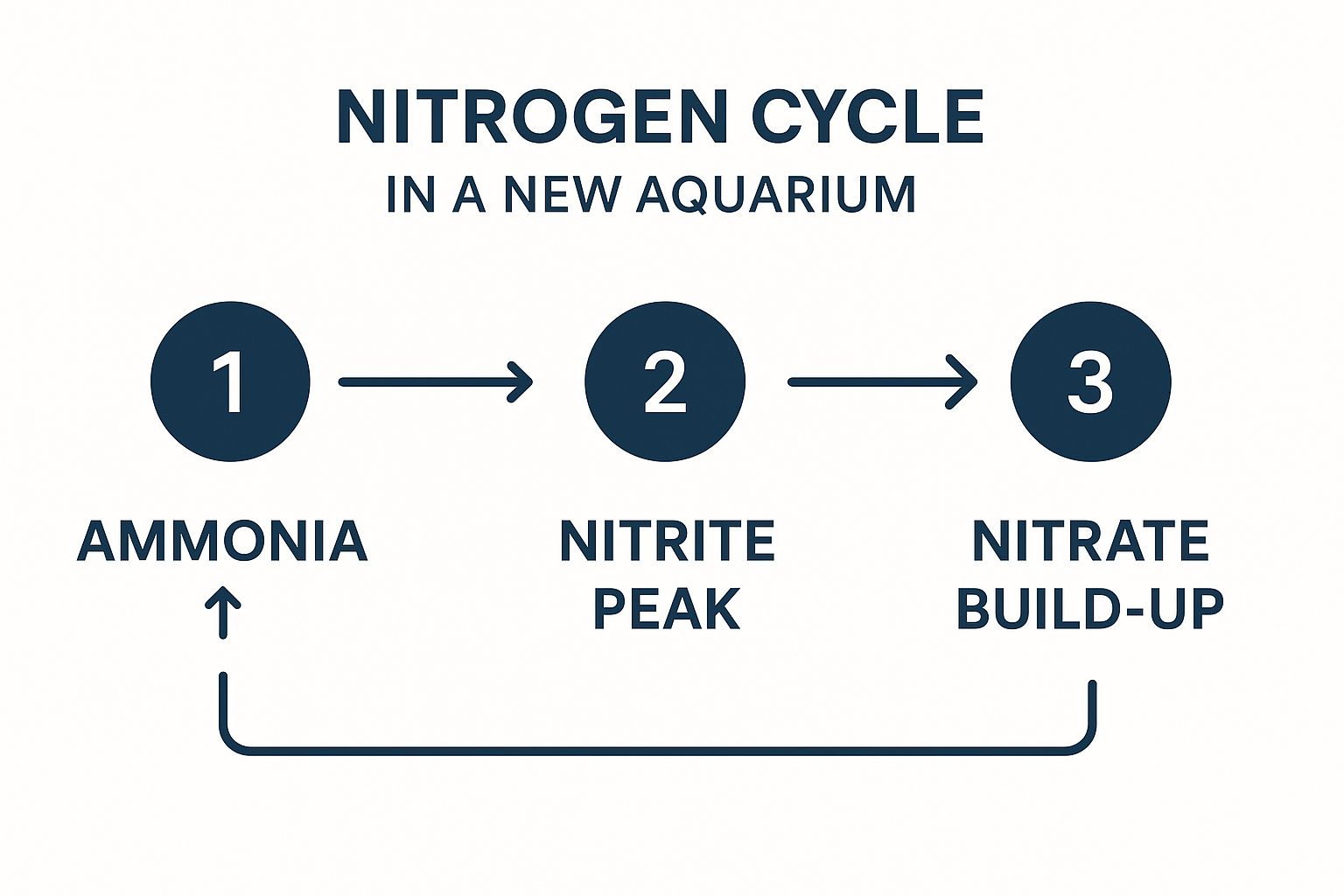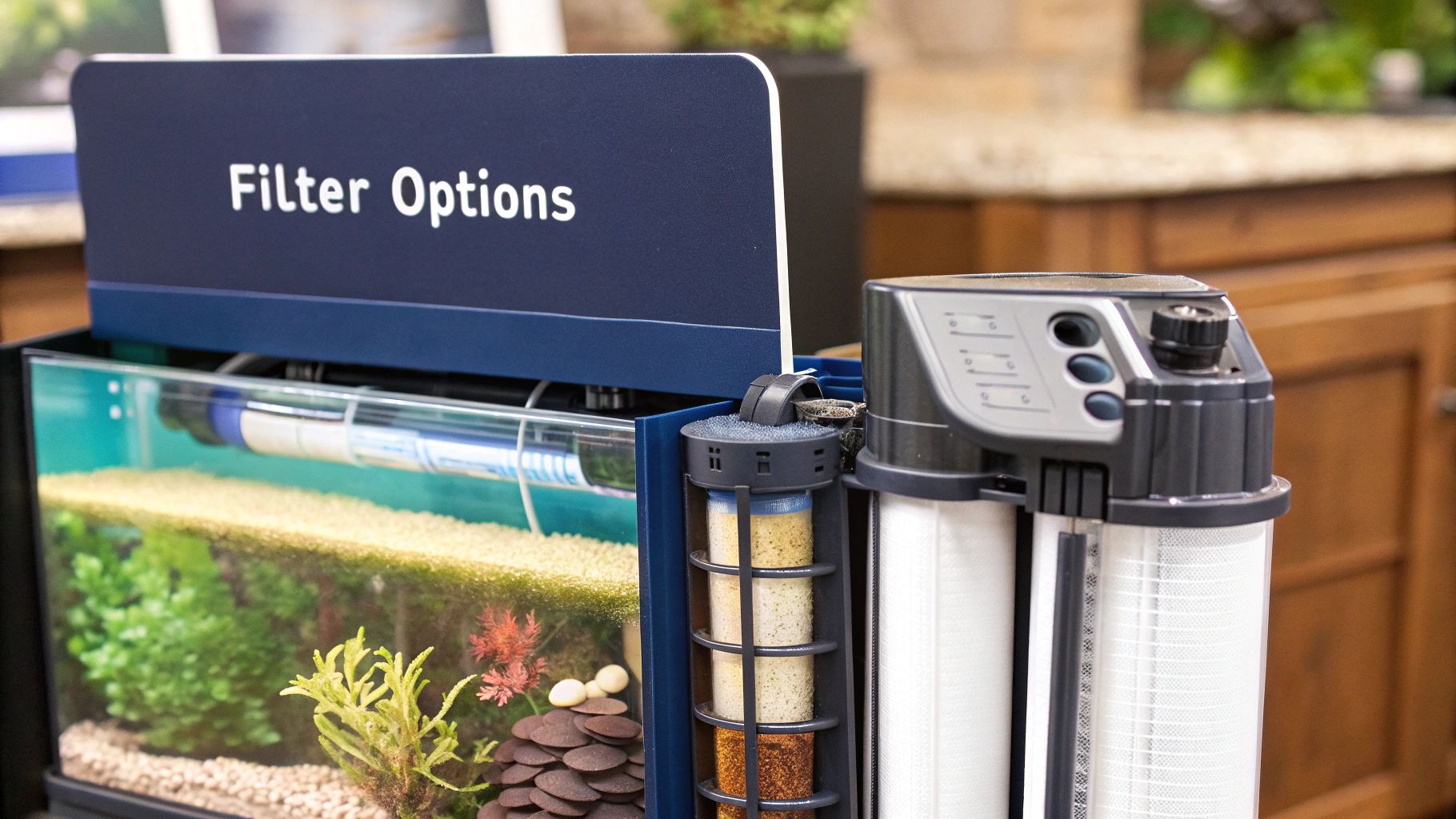Creating a stunning aquarium is about more than just picking colourful fish and fancy decorations. It's about becoming the architect of a tiny, thriving ecosystem, and that all starts with the water. What many people don't realise at first is that the water coming out of your tap, while perfectly safe for you, can be deadly for fish.
Getting the Water Right from Day One

The secret to a healthy tank isn't what you see; it's the invisible chemistry and biology at play. Here in the UK, our tap water is treated with chlorine and chloramine to kill off harmful bacteria. While great for public health, these chemicals are toxic to fish and, just as importantly, to the beneficial bacteria that keep an aquarium stable.
So, the very first job of any fishkeeper is to treat the water properly. The aim is to create a slice of a natural habitat right there in your living room, where waste is broken down and the water chemistry stays balanced. This brings us to the single most important concept in the hobby: the nitrogen cycle.
What Is the Nitrogen Cycle?
Think of the nitrogen cycle as your aquarium's invisible life-support system. It's a natural process where beneficial bacteria break down toxic waste into much safer substances. Without a healthy, established cycle, your tank would quickly become a toxic soup.
Here’s a quick rundown of how it works:
- Ammonia Appears: Fish waste and any leftover food break down, releasing highly toxic ammonia (NH₃) into the water. Even tiny amounts are harmful.
- Ammonia Is Converted: A colony of beneficial bacteria gets to work, consuming the ammonia and converting it into nitrite (NO₂). The problem is, nitrite is also extremely toxic to fish.
- Nitrite Is Converted: A second, different colony of bacteria then consumes the nitrite, converting it into nitrate (NO₃). Nitrate is far less harmful and is managed through regular water changes.
The whole process is why patience is a fishkeeper's greatest virtue. You absolutely must give these bacterial colonies time to grow on your filter media and gravel before you even think about adding fish. Rushing this stage is easily the most common and heartbreaking mistake new aquarists make.
Before you start, it helps to have a clear checklist of what you need to tackle first. This table breaks down the initial priorities for getting your water ready.
Initial Water Treatment Priorities
| Priority Action | Primary Purpose | Key Tools or Products |
|---|---|---|
| Dechlorination | To neutralise harmful chlorine and chloramine from tap water. | A quality water conditioner or dechlorinator. |
| "Cycling" the Tank | To establish the colonies of beneficial bacteria for the nitrogen cycle. | Ammonia source (fish food or pure ammonia), test kits. |
| Set Temperature | To provide a stable, appropriate environment for your chosen fish. | An aquarium heater and a reliable thermometer. |
This checklist covers the non-negotiable first steps. Getting these right lays the groundwork for a stable and healthy aquarium for years to come.
The growing interest in keeping fish responsibly has led to some fantastic new products and methods. The UK aquarium market is actually projected to grow from around £475 million in 2024 to over £870 million by 2035, a shift driven by people wanting better, more sustainable ways to maintain perfect water conditions. You can read more about these market trends over at FutureMarketInsights.com.
One of the best ways to simplify the entire process is to start with a clean slate. Using ultra-pure water from the get-go means you're not battling the cocktail of minerals and additives found in tap water. You can learn more about how ultra-pure water benefits aquariums on our website.
Making Tap Water Safe for Fish

Before you even think about adding fish, the tap water you fill your aquarium with needs some serious prep work. Here in the UK, water suppliers add disinfectants like chlorine and chloramine to our tap water. It’s great for making it safe for us to drink, but for fish, it's a completely different story.
These chemicals are highly toxic to fish and the beneficial bacteria that keep an aquarium healthy. Exposure can cause severe gill damage and can be lethal, sometimes shockingly quickly.
So, your very first job when setting up a tank or doing a water change is to neutralise these additives. The quickest and most common way to do this is with a liquid water conditioner, often just called a dechlorinator. These products get to work almost instantly, making both chlorine and chloramine harmless.
The golden rule is simple: treat the new water before it ever touches the aquarium. When you're doing a water change, get a separate bucket, add your fresh tap water, and then treat it. Pouring untreated water straight into your tank, even a little bit, is a recipe for disaster. It can stress your fish and wreck the delicate biological filter you've spent weeks establishing.
Decoding Water Conditioners
Walk into any pet shop and you’ll see a bewildering array of water conditioners on the shelves. They all tackle chlorine, but many of the better ones offer extra features that are genuinely useful.
- Chloramine Neutralisation: Standard dechlorinators break the bond in chloramine, but this can release ammonia into the water. The better conditioners go a step further and detoxify this leftover ammonia, keeping your fish safe.
- Heavy Metal Detoxification: Depending on the pipework in your home, tap water can pick up trace amounts of heavy metals like copper or zinc. A good conditioner will bind with these metals, rendering them harmless.
- Slime Coat Protection: Some formulas include ingredients like aloe vera to help support a fish's natural protective slime coat. This is a great feature for reducing stress, especially when you're adding new fish or after a big water change.
Always check the instructions on the bottle. A typical dose might be something like 5ml per 40 litres of water, but this really does vary by brand. It's better to be precise – underdosing is dangerous, while overdosing is usually harmless but wasteful.
Beyond Liquid Treatments
For serious aquarists, especially those keeping delicate species or running marine reef tanks, liquid treatments are just the beginning. Many experienced hobbyists prefer to start with completely pure water. This gives them a blank slate, free from any of the variables found in tap water. You can learn more by reading about how ultrapure water is not the same as your drinking water, which allows you to build the perfect water profile from scratch.
If you're aiming for that ultimate level of purity, it's worth looking into RO/DI water purification systems. These systems remove practically everything from the water—chlorine, heavy metals, phosphates, and nitrates—giving you the perfect foundation for creating a pristine aquatic environment.
Establishing the Nitrogen Cycle
If there's one thing every seasoned fishkeeper will tell you is non-negotiable, it's getting the nitrogen cycle right. Think of it as the foundation of your aquarium. It’s the natural process that turns a sterile glass box into a miniature, self-sustaining ecosystem. We're not going to get bogged down in heavy science; this is a practical guide to ‘cycling’ your new tank, ensuring it's a safe home for fish from day one.
The whole point of a 'fishless cycle' is to grow two specific types of beneficial bacteria. These microscopic workhorses set up camp on all the surfaces in your tank, but they especially love your filter media. They become a permanent, invisible clean-up crew, and without them, toxic fish waste would quickly reach deadly levels.
To kick things off, you'll need to add a source of ammonia to the fresh, clean water in your new setup. This acts as food for the first type of bacteria, giving them a reason to multiply. Once that colony is established, they'll start converting the ammonia into another nasty compound: nitrite. This, in turn, becomes the food source for the second type of bacteria, which then converts the harmful nitrite into the far more manageable nitrate.
You can see how this process unfolds over time. The levels of ammonia, nitrite, and nitrate rise and fall in a predictable sequence as each bacterial colony gets to work.

This classic pattern of peaks and troughs shown in your water tests is your visual confirmation that the cycle is progressing exactly as it should.
Tracking Your Cycle with Test Kits
You can't see this process happening, so a reliable liquid water testing kit is your best friend. Make sure it can measure ammonia, nitrite, and nitrate. You'll begin by adding enough ammonia to bring the level up to around 2-4 parts per million (ppm). From there, it's a case of testing the water every day or two.
For the first week or so, you'll only see an ammonia reading. Then, as the first bacterial colony finds its feet, you’ll notice nitrite appearing on your tests. As the nitrite level climbs, you'll see the ammonia level start to drop. The final piece of the puzzle is when the second bacterial colony gets going; nitrate will start to appear, and the nitrite level will finally fall back to zero.
Your tank is officially cycled and ready for fish only when it can fully process 2 ppm of ammonia into nitrate within 24 hours, leaving you with zero readings for both ammonia and nitrite. This isn't a quick job—it typically takes between four and eight weeks. Patience really is a virtue here.
Providing a Home for Bacteria
These vital bacteria don't just float about; they need a surface to anchor themselves to. That's the main purpose of your biological filter media. Things like ceramic rings, porous bio-balls, or even a good quality sponge are designed with a massive internal surface area specifically to house these colonies.
Here’s a golden rule: never replace all of your biological media at once. When it needs a clean, just give it a gentle swish in a bucket of old tank water that you've just removed during a water change. Using fresh tap water is a disaster, as the chlorine will wipe out your hard-earned bacterial colony and crash your cycle.
This focus on biological filtration is part of a wider shift in the UK's pet care world. Market trends show a growing investment in sustainable water conditioning, a sector forecast to expand at a steady 7% CAGR through to 2033. We're moving away from purely chemical fixes and embracing methods that use beneficial microbes to break down waste—a much more eco-conscious approach. This really mirrors broader UK strategies in wastewater treatment, where nature-based systems are now a priority. You can dig deeper into these aquarium market trends at ArchiveMarketResearch.com.
Choosing the Right Filtration System

Think of your aquarium filter as the engine room of the entire operation. It's much more than just a pump that pushes water around; it’s the central hub for the vital processes that keep your aquatic environment clean, clear, and, most importantly, safe for its inhabitants. Getting your water treatment right starts with a solid filtration strategy.
To nail it, you first have to realise that "filtration" isn't just one thing. It's actually a combination of three distinct processes working in harmony. A decent filter will perform all three, creating a powerful life-support system for your fish.
The Three Pillars of Filtration
Each filtration method tackles a different kind of problem, from the gunk you can see to the invisible toxins you can't.
- Mechanical Filtration: This is the most straightforward part of the job. It physically traps floating particles like fish waste, leftover food, and decaying plant matter. Sponges and filter floss are the workhorses here, keeping the water looking crystal clear.
- Biological Filtration: Here lies the absolute heart of your system. This is where the nitrogen cycle truly happens. Porous materials like ceramic rings or bio-balls provide a massive surface area for beneficial bacteria to grow, converting toxic ammonia and nitrite into much safer nitrate.
- Chemical Filtration: This involves using specific media to adsorb dissolved impurities that the other two methods miss. Activated carbon is a classic choice for pulling out odours, discolouration, and medications from the water.
Understanding these roles is key. For instance, the principles behind how ultra-pure water systems work focus on removing dissolved solids to achieve purity. It’s the same basic idea—actively removing unwanted substances from the water.
Comparing Popular Filter Types
When you're shopping around, you'll generally find three main types of filters on the UK market, each suited to different tank sizes and budgets. Before we dive into the options, here's a crucial piece of advice I've learned over the years.
Pro Tip: When cleaning your filter, never wash your biological media (like sponges or ceramic rings) under the tap. The chlorine in tap water will wipe out your beneficial bacteria colony instantly. Instead, just give it a gentle squeeze or swish in a bucket of the old tank water you’ve siphoned out.
This simple habit preserves your bacterial colony and stops your tank's cycle from crashing.
Now, let's look at a quick comparison to help you weigh up the options for your setup.
Aquarium Filter Type Comparison
Choosing the right filter often comes down to your tank's volume and the bioload (how much waste your fish produce). This table breaks down the most common choices to help you decide.
| Filter Type | Ideal Tank Size | Pros | Cons |
|---|---|---|---|
| Internal Filter | Small to medium (up to 100 litres) | Affordable, easy to install, and discreetly hidden inside the tank. | Can be bulky in smaller tanks and may have limited media capacity. |
| Hang-On-Back (HOB) | Medium (50-200 litres) | Sits on the back of the tank, offering easy access for maintenance and more room for different media. | Can be noisy and may require you to cut out a section of the aquarium lid. |
| External Canister | Large (150+ litres) | Offers superior filtration capacity, customisable media options, and keeps equipment out of sight. | More expensive and can be more complex to set up and maintain. |
Ultimately, the best choice really depends on your specific needs. A large tank with big, messy fish like cichlids will almost certainly demand a powerful external canister filter. On the other hand, a small tank with a few guppies will be perfectly happy with a simple and cost-effective internal filter.
Long-Term Water Quality and Maintenance
Getting your aquarium cycled and healthy is a huge milestone, but the real craft of fishkeeping is what comes next: keeping it stable for the long haul. Maintaining that crystal-clear water is a constant balancing act. You're always managing what goes in (food, waste) against what you take out through your maintenance routines.
Even the most powerful filter can't handle everything on its own. Over time, nitrates—the final stop in the nitrogen cycle—will inevitably start to climb. While they aren't nearly as dangerous as ammonia or nitrite, high nitrate levels stress your fish and act as the perfect fuel for nuisance algae, which can quickly turn a beautiful tank into a green, cloudy mess.
Starting with the Right Water
For many of us keeping fish in the UK, the quality of our tap water can be a real headache. It’s not just about the chlorine; tap water can come pre-loaded with high levels of nitrates and phosphates, giving algae a head start before you've even filled the tank. This is a bigger problem than many realise, and it ties directly into broader environmental issues.
In fact, serious river pollution incidents across England jumped by a staggering 60% in 2024-2025. Illegal sewage discharges release nitrates, phosphates, and even persistent 'forever chemicals' like PFAS into our water sources. These are the kinds of contaminants that standard water treatments struggle to remove, and they can easily build up in your aquarium, creating long-term health risks for your fish. You can read more about these environmental challenges in the UK wastewater industry on AdlerandAllan.co.uk.
This is exactly why so many dedicated aquarists eventually switch to Reverse Osmosis (RO) water. This purification method strips out pretty much every impurity, giving you a completely blank canvas to build your ideal water parameters from.
Starting with ultra-pure water is a game-changer, especially for:
- Delicate Fish: Species like Discus and many dwarf cichlids need incredibly soft, pure water to truly thrive—conditions that are almost impossible to achieve reliably with tap water.
- Marine Reef Tanks: Reef setups are incredibly sensitive to nitrates and phosphates. For them, RO water isn't a luxury; it's a necessity.
- High-Tech Planted Aquariums: Using RO water lets you add back only the specific minerals and nutrients your plants need, giving you total control over their growth and health.
Just remember, pure RO water is so clean that it’s empty. It contains none of the essential minerals fish need, so you absolutely must add them back in using a dedicated remineralising product designed for aquarium use.
The Water Change Ritual
There’s no getting around it: regular water changes are the foundation of a healthy, long-lasting aquarium. They are, without a doubt, the most effective tool you have for diluting those nitrates, getting rid of dissolved organic gunk, and topping up the trace elements that your fish and plants use up.
Consistency is key. A routine schedule of partial water changes is infinitely better for your tank's stability than doing massive, infrequent ones. Sudden, large changes can shock your fish and wreck the delicate biological balance you've worked so hard to create.
For the vast majority of freshwater tanks, changing 25-30% of the water once a week is a solid gold standard. This simple routine keeps pollutants from ever reaching dangerous levels and ensures your tank's environment stays predictable and safe.
Before you add the new water, always treat it with a good dechlorinator. It’s also a good idea to get the temperature as close as possible to the tank water to avoid a sudden chill that could stress your fish.
Common Aquarium Water Treatment Questions
Even with the best planning, fishkeeping will always throw a few curveballs your way. It’s all part of the journey. Think of this section as a chat with an old hand, covering some of the most common hiccups you might encounter and helping you fix them with confidence.
Why Has My New Aquarium Water Gone Cloudy?
This is, without a doubt, the question I hear most from people new to the hobby. If your tank has only been running for a few weeks, what you're seeing is almost certainly a "bacterial bloom." Don't panic!
This milky, hazy water is actually a good thing. It means the beneficial bacteria we've been talking about are getting established and multiplying like crazy. The absolute best thing you can do is leave it alone. Do not perform a large water change, as that will just reset the process. Have a bit of patience, and the cloudiness will disappear on its own in a week or so as the bacterial colonies find their balance.
Of course, if a well-established tank suddenly goes cloudy, that's a different story. It usually points to overfeeding or a small crash in your cycle. In that case, grab your test kit and check for ammonia and nitrite right away.
How Often Should I Really Test My Water?
This really depends on where you are in your tank's life. There’s no single right answer, but here’s a good guide based on my experience.
- During the Initial Cycle: You'll want to test for ammonia, nitrite, and nitrate every 1-2 days. This is the only way to truly know what's going on and to pinpoint the exact moment your tank is safe for fish.
- For a Newly Stocked Tank (First 1-2 Months): Test twice a week. You're keeping a close eye on how the biological filter is handling the new arrivals.
- For an Established, Stable Tank: A quick check once a week is plenty. It’s just a routine MOT to make sure everything is ticking along nicely and to spot any trouble before it starts.
What’s the Best Way to Deal with Algae?
Ah, algae. It’s a sign that your little ecosystem is out of whack, usually from too much light and an excess of nutrients like nitrates and phosphates. Scraping it off the glass is satisfying, but it's just treating the symptom, not the cause.
The only real long-term solution is to get control of the nutrients. Your best weapon against algae, hands down, is a consistent weekly water change. This physically removes the nitrates that are feeding it.
Beyond that, take a look at your lighting. Are the lights on all day? Try cutting the photoperiod back to around 8 hours. Also, be honest about feeding. Uneaten food just rots down into more algae fuel. Combining these simple habits is the most surefire way to keep your tank looking clean and clear.
Ready to build your aquarium on the best possible foundation? 24 Pure Water gives you 24/7 access to ultra-pure water across the nation, cutting out tap water troubles from the very beginning. Find your nearest self-service station and give your fish the pristine start they deserve.
